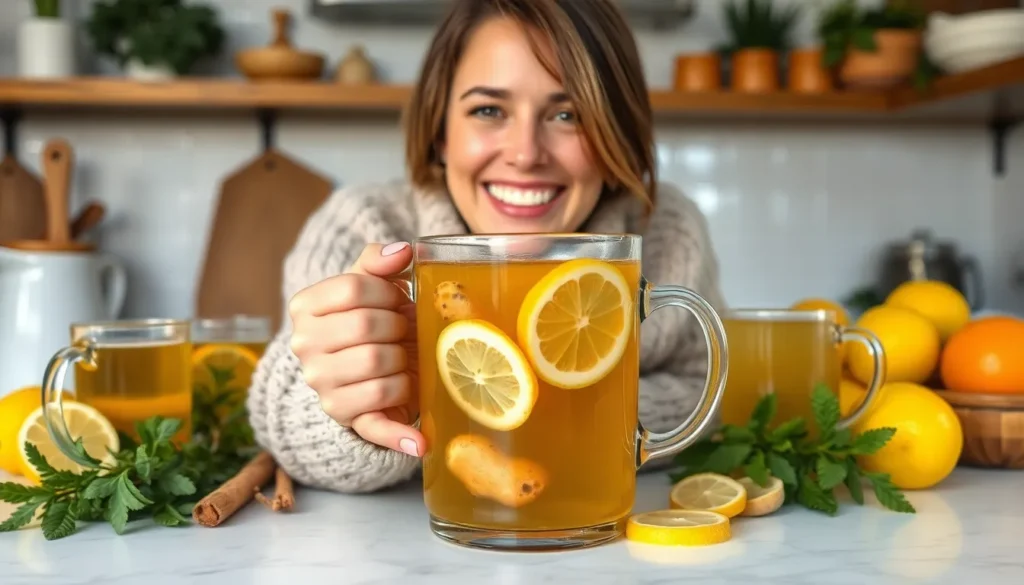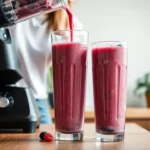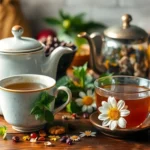When cold season strikes and we’re feeling under the weather, nothing beats the comfort of a warm, healing cup of tea. For centuries, cultures around the industry have turned to herbal and traditional teas as natural remedies to soothe sore throats, clear congestion, and boost immunity during illness.
We’ve gathered the most effective tea recipes that combine powerful ingredients like ginger, honey, lemon, and healing herbs to help you fight off cold symptoms naturally. These time-tested blends don’t just taste amazing – they’re packed with antioxidants, anti-inflammatory compounds, and immune-boosting properties that can help speed up your recovery.
Whether you’re battling a scratchy throat, stuffy nose, or just feeling run down, these simple yet potent tea recipes will become your go-to remedies. Let’s explore how the right combination of ingredients can transform your daily cup into a healing elixir that supports your body’s natural defenses.
Essential Ingredients for Cold-Fighting Teas
Building effective cold-fighting teas requires selecting ingredients that work synergistically to combat symptoms and boost immunity. We focus on natural components that provide therapeutic benefits while creating delicious and soothing beverages.
Fresh Herbs and Spices
Fresh ginger stands as our most powerful ally against cold symptoms with its natural anti-inflammatory and antimicrobial properties. We recommend using 1-2 inches of fresh ginger root per cup of tea for optimal potency. Turmeric brings curcumin compounds that reduce inflammation and support immune function when we add 1/2 teaspoon of fresh grated turmeric or 1/4 teaspoon of dried powder.
Peppermint leaves offer natural decongestant properties that clear nasal passages and soothe throat irritation. We use 1 tablespoon of fresh peppermint leaves or 1 teaspoon of dried leaves per cup. Eucalyptus leaves provide menthol compounds that open airways and reduce coughing when we steep 1-2 fresh leaves or 1/2 teaspoon of dried eucalyptus.
Cinnamon bark contains powerful antioxidants and antimicrobial compounds that fight infection. We add one cinnamon stick per cup or 1/2 teaspoon of ground cinnamon for immune support. Fresh thyme delivers thymol and carvacrol compounds that act as natural expectorants when we use 1 teaspoon of fresh thyme leaves.
Citrus Fruits and Juices
Lemons provide high concentrations of vitamin C and citric acid that support immune function and help break down mucus. We squeeze juice from half a fresh lemon into each cup of tea for maximum vitamin absorption. Fresh lemon zest adds limonene compounds that enhance the therapeutic effects when we grate 1 teaspoon of zest per serving.
Oranges deliver additional vitamin C along with flavonoids that reduce inflammation and support respiratory health. We use juice from 1/4 fresh orange or add 2-3 thin orange slices during steeping. Lime juice provides citric acid and vitamin C in concentrated form when we add 1 tablespoon of fresh lime juice per cup.
Grapefruit offers naringenin compounds that support immune function and reduce congestion. We incorporate 2 tablespoons of fresh grapefruit juice or steep 2-3 grapefruit peel strips for added benefits.
Natural Sweeteners
Raw honey serves as our primary sweetener while providing antimicrobial properties and throat-soothing enzymes. We add 1-2 tablespoons of raw honey per cup after tea has cooled slightly to preserve beneficial enzymes. Manuka honey offers enhanced antibacterial properties when we use 1 tablespoon per serving for more severe symptoms.
Maple syrup provides minerals and antioxidants while adding natural sweetness that complements spicy ingredients. We use 1-2 teaspoons of pure maple syrup per cup as an alternative to honey. Stevia leaves offer natural sweetness without affecting blood sugar when we add 2-3 fresh stevia leaves or 1/8 teaspoon of stevia extract.
Coconut palm sugar contains minerals and has a lower glycemic impact when we need additional sweetening power. We incorporate 1 teaspoon per cup for balanced flavor.
Medicinal Add-ins
Apple cider vinegar with the mother provides probiotics and acetic acid that support immune function and help alkalize the body. We add 1-2 teaspoons of raw apple cider vinegar per cup for digestive and immune support. Coconut oil delivers medium-chain triglycerides that have antimicrobial properties when we stir in 1 teaspoon of virgin coconut oil.
Cayenne pepper contains capsaicin compounds that reduce congestion and provide natural pain relief. We add just a pinch of cayenne pepper per cup to avoid overwhelming heat while gaining therapeutic benefits. Fresh garlic offers allicin compounds with powerful antimicrobial effects when we crush 1 small clove and steep for 5 minutes.
Elderberry syrup provides anthocyanins and antioxidants that support immune function and reduce cold duration. We add 1-2 tablespoons of elderberry syrup per cup for enhanced viral protection. Echinacea tincture delivers immune-supporting compounds when we add 1/2 teaspoon per serving according to product instructions.
Equipment and Tools Needed
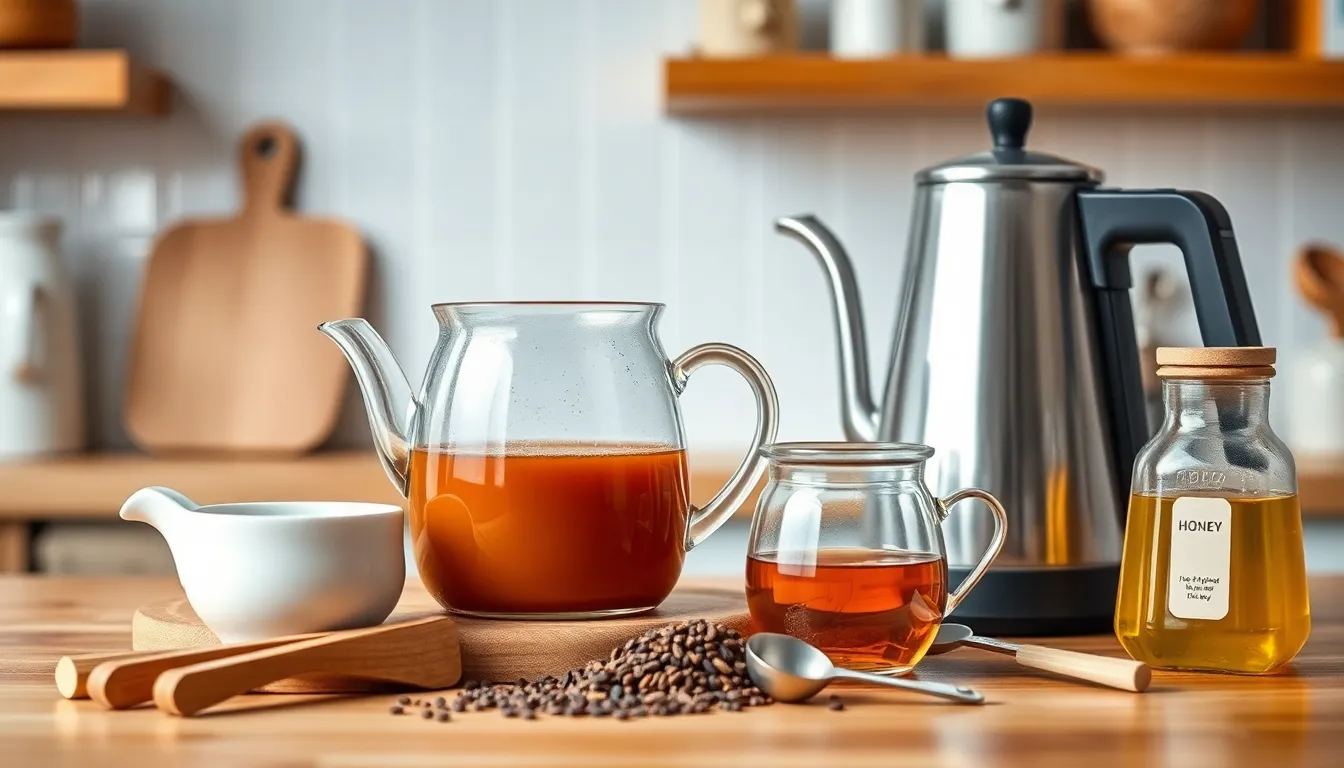
Preparing effective cold remedy teas requires the right equipment to extract maximum benefits from our healing ingredients. We’ll guide you through essential brewing tools and helpful additions that enhance our tea preparation process.
Basic Tea Brewing Equipment
Our cold remedy teas start with fundamental brewing equipment that every kitchen should have. Teapots serve as the foundation for proper steeping, allowing ingredients to infuse completely while maintaining optimal temperature. Kettles provide precise water heating, ensuring we reach the ideal temperature for different tea types without destroying beneficial compounds.
Tea steepers or infusers contain loose ingredients while allowing full water circulation for maximum extraction. Standard cups or mugs complete our basic setup, though we recommend using ceramic or glass materials that won’t affect flavor profiles.
A reliable measuring spoon set ensures accurate ingredient ratios, particularly important when working with potent additions like turmeric or cayenne pepper. Small mixing spoons help incorporate honey and other add-ins thoroughly without cooling our tea too quickly.
Optional Specialized Tools
Advanced tea preparation benefits from specialized equipment that elevates our cold remedy brewing. Fine mesh strainers remove all plant material and spice particles, creating smooth teas that are easier to drink when we have sore throats.
Tea infusers with removable baskets allow us to control steeping time precisely, preventing over-extraction that can create bitter flavors. Cinnamon stick holders keep whole spices organized while they steep, making removal simple and mess-free.
Digital thermometers help us achieve the perfect water temperature of 100°F (38°C) for our Ultimate Cold Relief Home Remedy Tea. Timer devices ensure we steep our Organic Cold Remedy tea leaves for the full 7 minutes needed for maximum potency.
Honey dispensers provide easy addition of raw honey without crystallization issues, while citrus reamers extract maximum juice from fresh lemons and other citrus fruits we use in our recipes.
Honey Lemon Ginger Tea
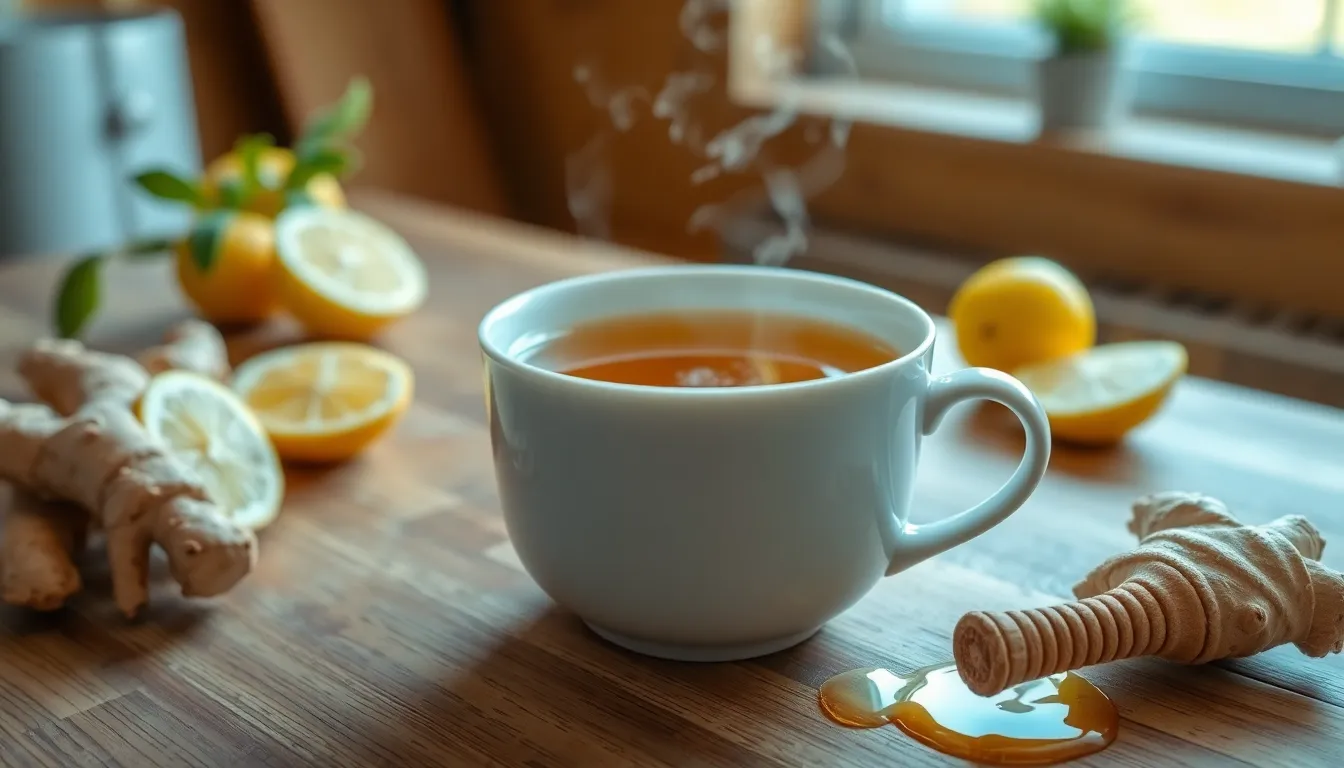
This powerful triple combination creates one of our most effective cold-fighting brews. We blend warming ginger with immune-boosting lemon and soothing honey to deliver maximum therapeutic benefits.
Ingredients
- 4-inch piece fresh ginger root, roughly sliced (or finely grated)
- 3½ to 4 cups water
- Juice of 1 to 2 lemons (approximately 3 tablespoons)
- 2 tablespoons honey (or to taste)
- ¼ teaspoon ground cinnamon (optional)
- Lemon slices for garnish (optional)
Instructions
- Prepare the ginger base by adding water and sliced ginger to a small pot. Bring the mixture to a rolling boil then reduce heat to maintain a gentle simmer.
- Simmer for 15 minutes while partially covering the pot to allow the ginger’s potent compounds to infuse thoroughly into the water.
- Strain the ginger water by removing all ginger pieces or pouring through a fine mesh strainer to eliminate any remaining bits.
- Add healing elements by pouring the hot ginger water into your mug and stirring in fresh lemon juice and honey until completely dissolved.
- Adjust flavors by tasting and adding more honey for sweetness or lemon juice for tartness according to your preference.
- Enhance with spice by adding a pinch of cinnamon for extra warmth and additional cold-fighting properties if desired.
Serving Suggestions
We recommend serving this tea hot or warm to maximize its soothing effects on sore throats and congestion. The optimal temperature helps release the steam that can clear nasal passages while delivering the full therapeutic benefits of each ingredient.
Store prepared ginger water in the refrigerator for up to 3 days for convenient reheating when cold symptoms strike. This traditional remedy works best when consumed during the early stages of cold symptoms or as a daily preventative measure throughout cold season.
Garnish with fresh lemon slices to boost vitamin C content and create an appealing presentation that encourages regular consumption for ongoing immune support.
Echinacea Elderberry Tea
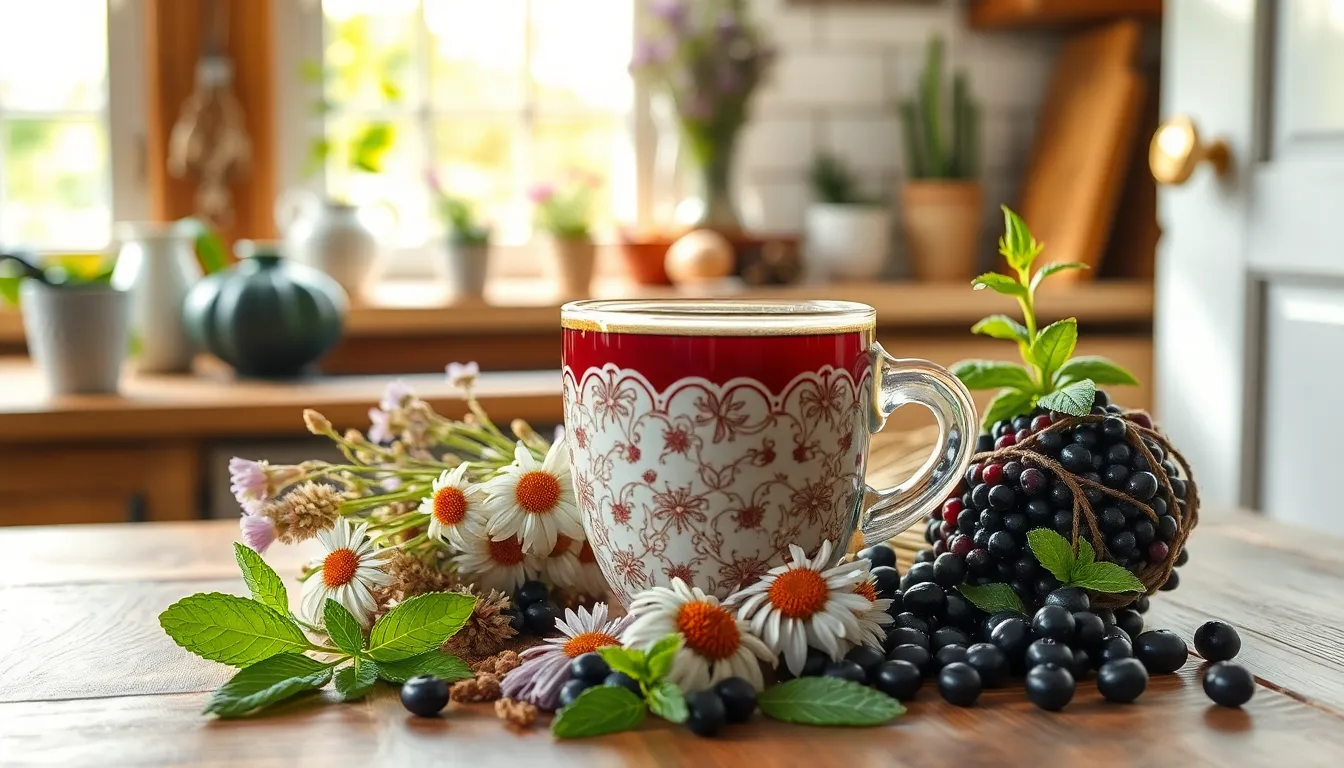
Building on the foundation of ginger and lemon remedies, we turn to a powerful herbal blend that combines traditional immune-supporting botanicals. This echinacea elderberry tea creates a potent cold-fighting elixir that harnesses the strength of multiple healing herbs in one comforting cup.
Ingredients
- 4 grams dried elderberries
- 4 grams dried echinacea flower
- 2 grams dried yarrow leaf and flower
- 2 grams dried tulsi (holy basil)
- 4 grams dried peppermint
- 2 quarts filtered water
- Raw honey (optional)
Instructions
- Boil the water: We bring 2 quarts of filtered water to a rolling boil in our kettle or large pot.
- Combine the herbs: We measure all dried herbs and combine elderberries, echinacea flower, yarrow, tulsi, and peppermint in a large heat-proof jar or teapot.
- Pour and steep: We carefully pour the boiling water over our herb mixture and cover with a tight-fitting lid. The tea steeps for exactly 10 minutes to extract maximum beneficial compounds.
- Strain and serve: We strain out all plant material using a fine mesh strainer and sweeten with raw honey to taste if desired. The tea serves immediately while hot for optimal therapeutic benefits.
Health Benefits
Our carefully selected herb combination delivers targeted immune support through multiple pathways. Elderberries provide rich antioxidants that may help reduce both the severity and duration of cold symptoms. Echinacea flower contributes well-documented immune-boosting properties that research suggests can shorten cold duration significantly.
Yarrow adds anti-inflammatory compounds while supporting healthy digestion during illness recovery. Tulsi brings powerful antioxidant properties that work synergistically to enhance overall immune function. Peppermint rounds out our blend by soothing digestive discomfort and providing a refreshing taste that makes the medicine more palatable.
We recommend consuming this tea hot for maximum therapeutic impact. Leftover portions can be refrigerated for 1-2 days, though fresh preparation yields the strongest potency. Always consult healthcare professionals before using herbal remedies, particularly if you have known allergies or existing health conditions.
Turmeric Golden Milk Tea
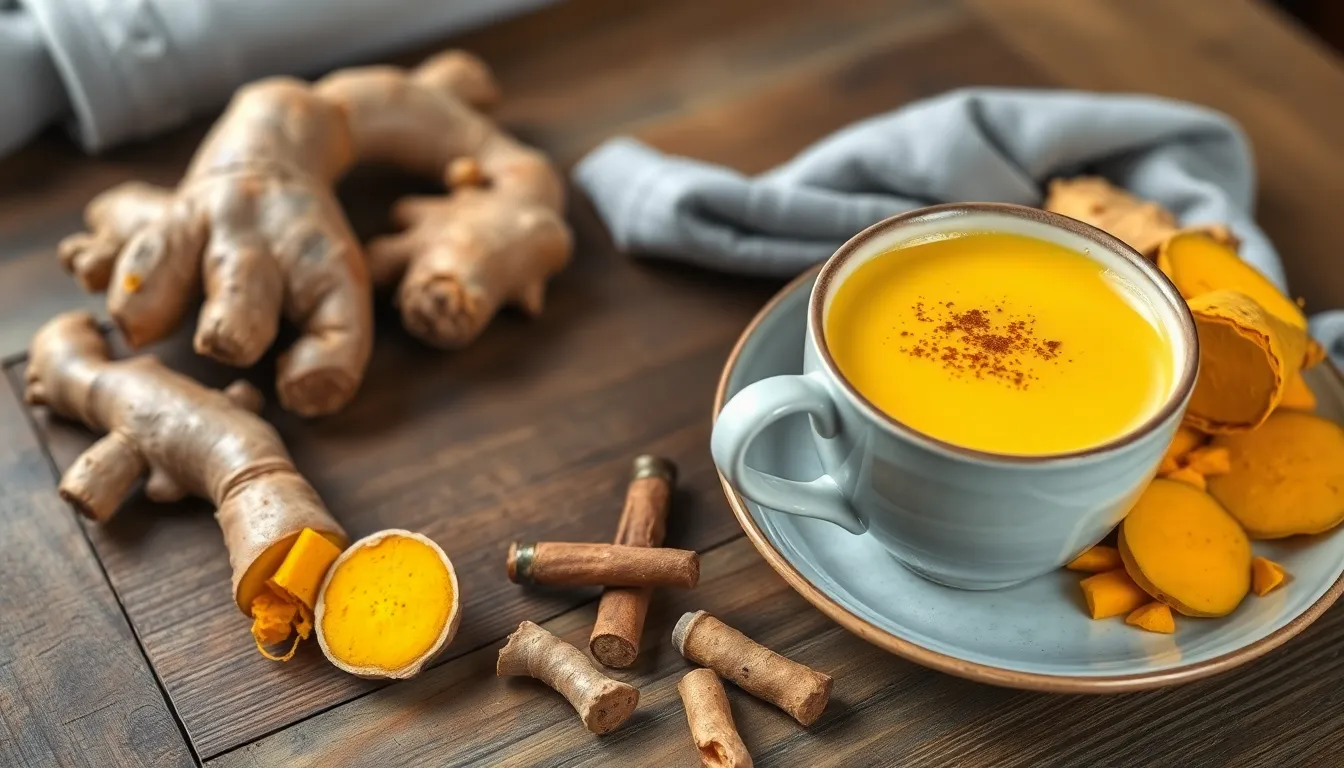
Our golden milk tea transforms traditional Ayurvedic healing into a comforting cold remedy. This vibrant blend harnesses turmeric’s powerful anti-inflammatory compounds to soothe throat irritation and support recovery.
Ingredients
- 1 cup milk (dairy or plant-based such as coconut, almond, or oat)
- ½ teaspoon ground turmeric
- ¼ teaspoon ground ginger (or fresh)
- Pinch black pepper
- ¼ teaspoon ground cinnamon (optional: for topping)
- ⅛ teaspoon ground cardamom (optional)
- 1 teaspoon honey or maple syrup
- ¼ teaspoon vanilla extract (optional)
- For tea variation: ½ tablespoon green tea leaves and ½ cup hot water
Instructions
Step 1: Heat milk in a small pot over medium heat until steaming.
Step 2: Whisk in turmeric, ginger, cinnamon, cardamom, and black pepper into the warm milk.
Step 3: Simmer the mixture for 5 minutes to infuse flavors thoroughly.
Step 4: Add honey and vanilla extract, whisking until honey dissolves completely.
Step 5: Pour into a mug and strain if desired for smoother texture.
Step 6: Top with additional cinnamon before serving.
For tea variation: Steep ½ tablespoon green tea in ½ cup hot water for 3 minutes, strain, then combine with prepared golden milk mixture in step 4.
Anti-inflammatory Properties
Turmeric contains curcumin, which provides anti-inflammatory, antioxidant, antibacterial, antiviral, and antifungal effects that directly combat cold symptoms. Black pepper enhances curcumin absorption significantly, maximizing turmeric’s therapeutic benefits. Ginger adds complementary anti-inflammatory properties while soothing throat irritation naturally.
| Ingredient | Primary Benefit | Cold Fighting Action |
|---|---|---|
| Turmeric (Curcumin) | Anti-inflammatory | Reduces throat inflammation |
| Black Pepper | Absorption enhancer | Increases curcumin bioavailability |
| Ginger | Anti-inflammatory | Soothes sore throat symptoms |
Regular consumption helps reduce cold-related inflammation and provides natural relief for sore throats. We recommend drinking this golden milk warm before bedtime or when cold symptoms first appear for maximum therapeutic impact.
Peppermint Eucalyptus Steam Tea
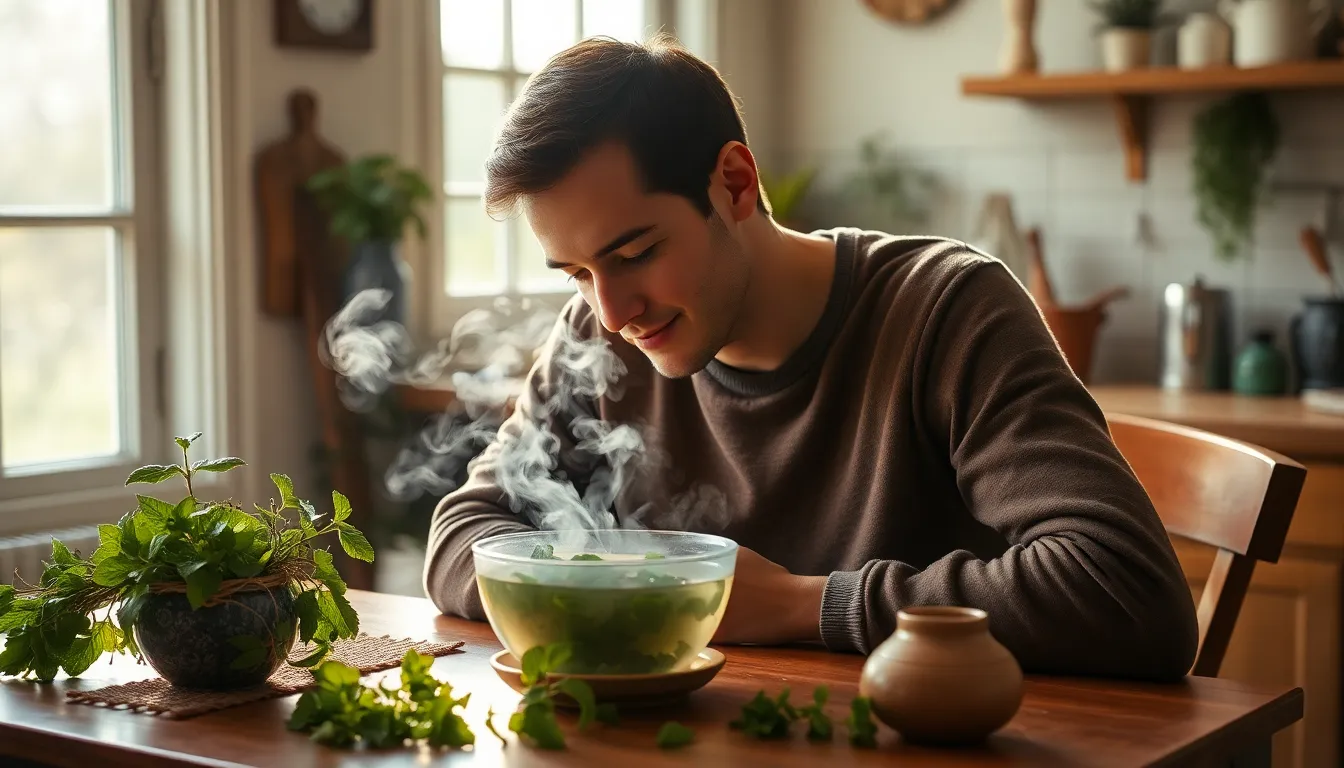
We combine the power of aromatic inhalation therapy with traditional herbal healing in this effective steam treatment. This dual-purpose recipe transforms the soothing properties of peppermint and eucalyptus into a direct respiratory relief method that opens airways and clears congestion.
Ingredients
- 1-2 cups boiling water
- 1 tablespoon dried or fresh eucalyptus leaves
- 1 tablespoon dried or fresh peppermint leaves
- Optional: Additional aromatic herbs such as elder flower or thyme for enhanced benefits
Instructions
- Bring water to a rolling boil in a kettle or large pot.
- Place eucalyptus and peppermint leaves in a heat-safe bowl or wide-mouth pot that can comfortably accommodate your face positioning.
- Pour the boiling water over the herbs and immediately cover with a lid to allow steeping for 5-10 minutes.
- Remove the lid carefully and position your face 10-12 inches above the bowl to avoid steam burns.
- Drape a large towel over your head to create a tent that traps the therapeutic steam around your face.
- Inhale the vapors slowly and deeply for 5-10 minutes while keeping your eyes closed to prevent irritation.
Aromatherapy Benefits
Peppermint delivers menthol compounds that naturally open nasal passages and provide immediate relief from sinus congestion. The cooling sensation helps reduce inflammation in irritated respiratory tissues while promoting easier breathing.
Eucalyptus contributes cineole, a powerful compound that soothes inflamed airways and acts as a natural decongestant. This therapeutic component reduces respiratory inflammation and helps break up stubborn mucus buildup.
| Herb | Active Compound | Primary Benefit |
|---|---|---|
| Peppermint | Menthol | Opens nasal passages, relieves congestion |
| Eucalyptus | Cineole | Reduces inflammation, acts as decongestant |
The combined steam effect amplifies both herbs’ natural properties while the warm moisture soothes irritated throat tissues. This aromatherapy treatment calms the entire respiratory system and provides a meditative moment during recovery. We can enhance the steam by adding 1-2 drops of essential oils, though direct skin and eye contact should be avoided for safety.
Green Tea with Manuka Honey
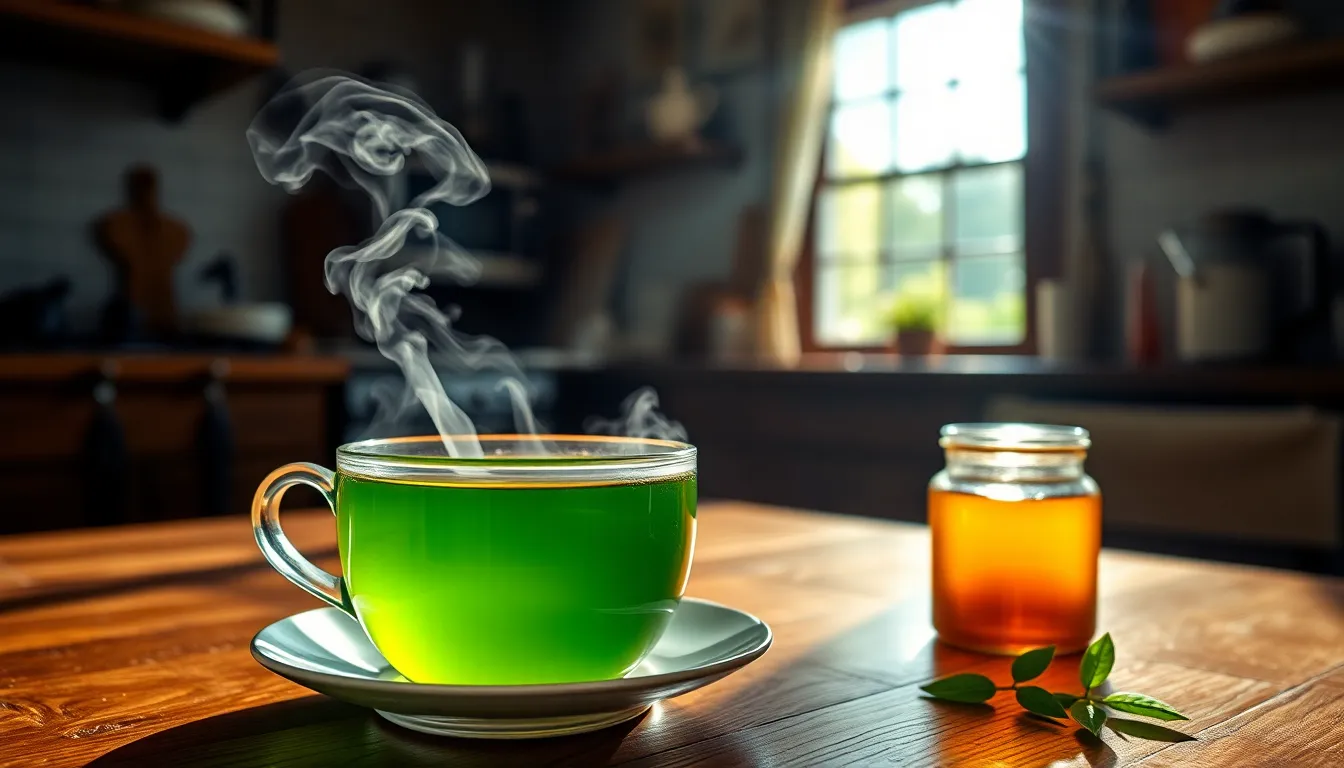
We combine the delicate antioxidant power of green tea with the antibacterial properties of Manuka honey to create a gentle yet effective cold remedy. This soothing blend supports our immune system while providing throat relief during cold symptoms.
Ingredients
- 1 green tea bag or 1 teaspoon loose green tea leaves
- 1 cup hot water (about 90–95°C/194–203°F, not boiling)
- 1–2 teaspoons Manuka honey
Instructions
Steep the Tea: We place green tea in a cup and pour hot water over it. Let the tea steep for 2–3 minutes to extract optimal antioxidants without creating bitterness.
Add Honey: We remove the tea bag or strain out the leaves completely. Stir in 1–2 teaspoons of Manuka honey until fully dissolved for even sweetness and maximum therapeutic benefit.
Serve Warm: We drink the tea while warm for best results. Repeat this process 2–3 times daily while experiencing cold symptoms for consistent immune support.
Temperature Control: We avoid boiling water to preserve green tea’s delicate antioxidants and prevent damaging the beneficial compounds.
Quality Matters: We use genuine high-grade Manuka honey for optimal antibacterial properties and enhanced healing effects.
Antioxidant Boost
Green tea delivers rich antioxidants, particularly catechins, which help support our immune system and may reduce inflammation throughout the body. Manuka honey contains unique compounds such as methylglyoxal that provide additional antibacterial and soothing properties for throat irritation. We benefit from both immune support and throat soothing effects when combining these powerful ingredients.
| Ingredient | Purpose | Benefits |
|---|---|---|
| Green Tea | Antioxidant support | Rich in catechins, supports immune system, reduces inflammation |
| Manuka Honey | Antibacterial action | Contains methylglyoxal, soothes throat, provides antimicrobial properties |
Our consistent consumption of this tea throughout cold symptoms maximizes relief and supports natural recovery processes. We recommend drinking this blend regularly during cold season for ongoing immune protection and symptom management.
Chamomile Lavender Throat Soother
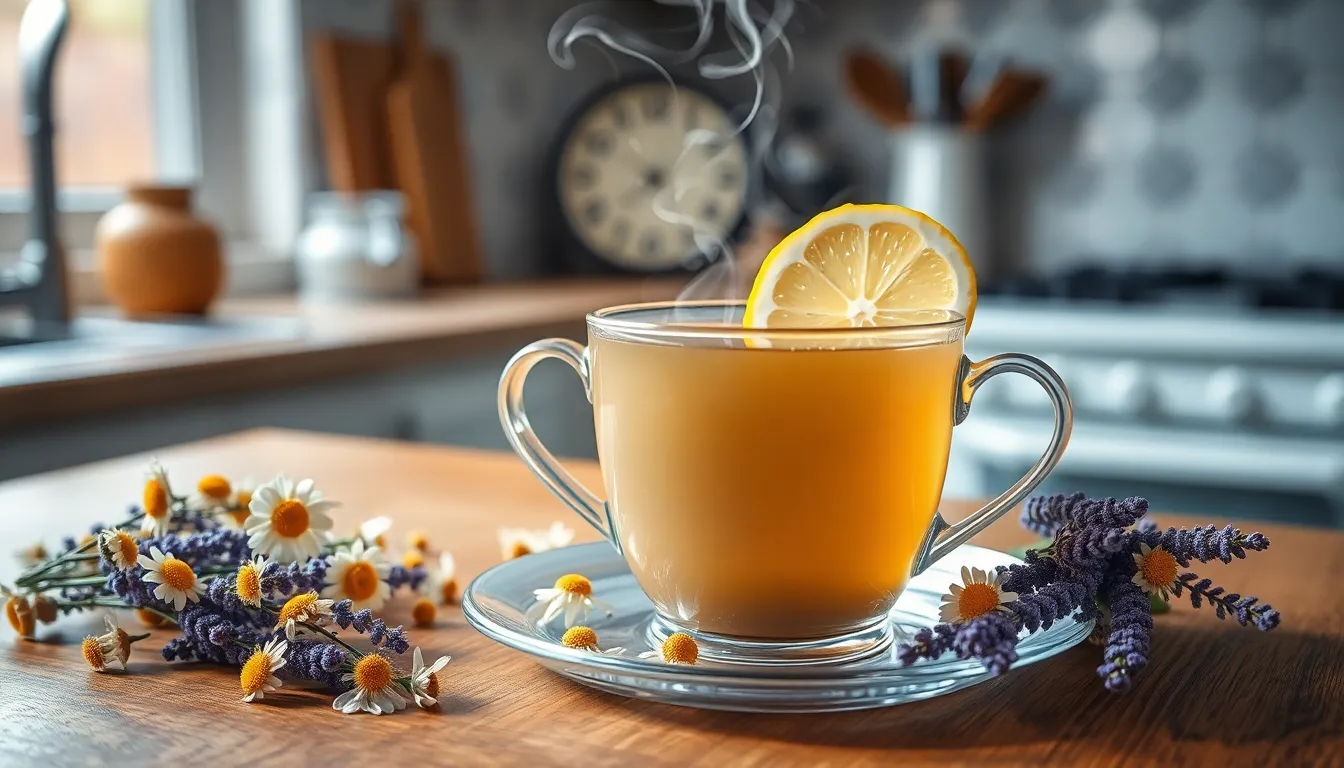
We turn to this gentle herbal blend when our throats need extra care during cold recovery. This soothing combination harnesses the calming power of chamomile and lavender to provide natural relief while promoting restful healing.
Ingredients
- 1 tablespoon dried chamomile flowers
- 1 tablespoon dried lavender buds
- 1 cup boiling water
- 1 tablespoon honey (optional)
- Lemon slices (optional)
Instructions
- Combine the herbs in a tea infuser or heat-resistant cup by adding the dried chamomile flowers and lavender buds together.
- Pour boiling water over the herbal mixture to fully cover the botanicals.
- Steep for 5 to 7 minutes to allow the herbs to release their therapeutic compounds into the water.
- Strain the tea into your favorite mug to remove the herb particles.
- Add honey to taste if desired for natural sweetness and additional throat-soothing properties.
- Garnish with a lemon slice for enhanced flavor and extra vitamin C support.
Calming Effects
Both chamomile and lavender create a powerful partnership for throat relief and overall wellness during cold symptoms. These herbs deliver natural calming effects that help soothe irritated throat tissues while promoting the relaxation your body needs for optimal recovery.
Our bodies benefit significantly from the anti-inflammatory properties found in both botanicals. Chamomile and lavender work synergistically to reduce inflammation throughout the respiratory system while supporting digestive health during illness recovery.
| Herb | Primary Benefits | Recovery Support |
|---|---|---|
| Chamomile | Anti-inflammatory, digestive support | Reduces throat irritation, promotes healing |
| Lavender | Calming, relaxation | Improves sleep quality, reduces stress |
Regular consumption of this blend before bedtime enhances sleep quality during cold recovery. The relaxing properties of lavender combined with chamomile’s gentle sedative effects create an ideal environment for restorative rest. We recommend drinking this tea warm to maximize its throat-soothing benefits while allowing the aromatic compounds to provide additional respiratory comfort through gentle inhalation.
Spiced Chai Cold Remedy
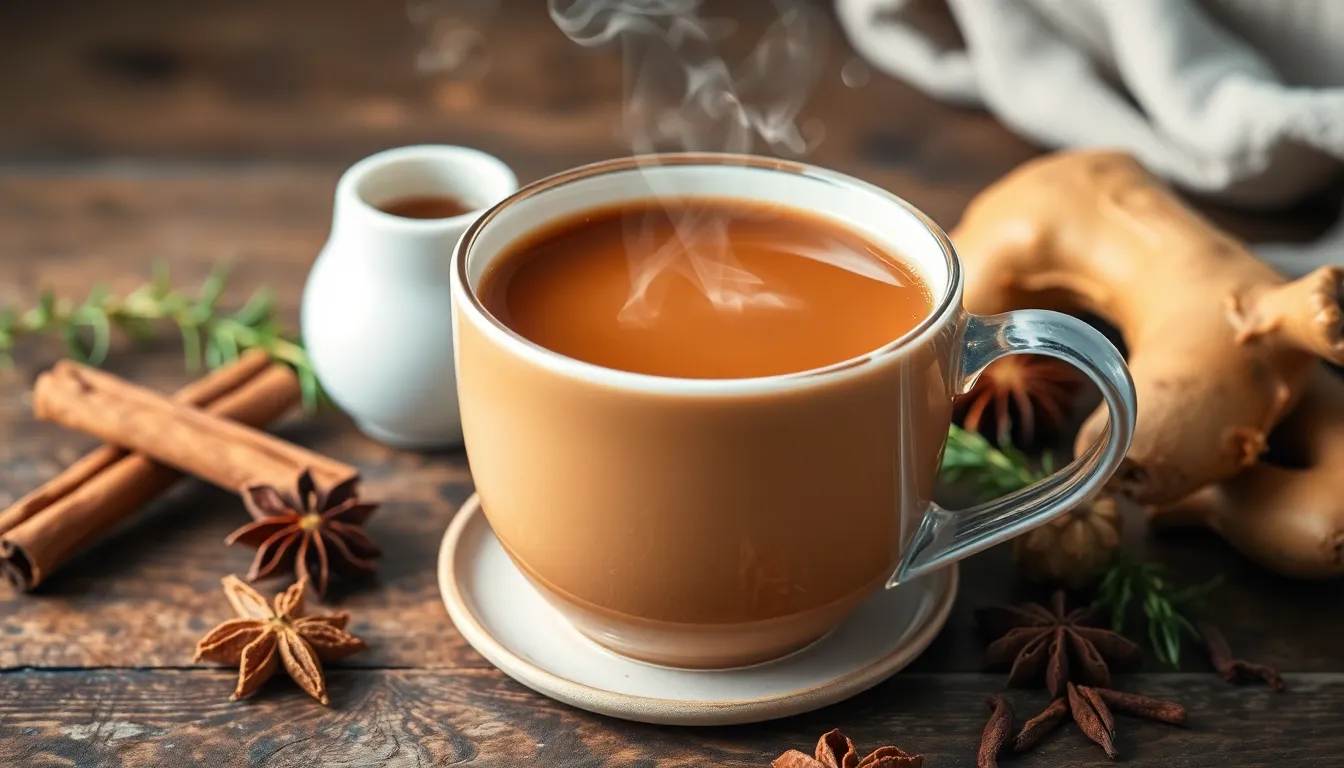
We transform traditional chai into a powerful cold-fighting elixir by combining warming spices with immune-boosting ingredients. This aromatic blend harnesses the natural healing properties of black tea and therapeutic spices to provide comfort and relief during cold symptoms.
Ingredients
- 1 cup water (or coconut milk for creamier texture)
- 1 black tea bag or 1 tsp loose black tea
- 1 cinnamon stick or ¼ tsp ground cinnamon
- 2 whole cloves or ¼ tsp ground cloves
- 2 cardamom pods (crushed) or ¼ tsp ground cardamom
- 1 small piece fresh ginger, sliced (about 1 inch) or ¼ tsp ground ginger
- A pinch of black pepper
- 1 tsp raw honey (optional)
- ½ tsp lemon juice (optional)
Instructions
Step 1: Boil Water
We bring water to a rolling boil in a small saucepan over medium-high heat.
Step 2: Add Spices and Tea
We add black tea, cinnamon, cloves, cardamom, ginger, and black pepper to the boiling water. Reduce heat to low and simmer the mixture for 5 to 7 minutes to extract maximum flavor and therapeutic compounds.
Step 3: Strain and Serve
We remove the saucepan from heat and strain the spiced tea into a cup using a fine mesh strainer.
Step 4: Sweeten
We stir in honey and lemon juice if desired for additional immune support and throat soothing properties.
Step 5: Drink
We enjoy this warming remedy while hot to maximize its therapeutic benefits.
Warming Spice Benefits
Our spiced chai remedy combines multiple therapeutic ingredients that work synergistically to combat cold symptoms:
| Ingredient | Primary Benefits |
|---|---|
| Black Tea | Contains antioxidants and supports immune function |
| Cinnamon | Provides anti-inflammatory and antimicrobial properties |
| Cloves | Offers pain relief and antibacterial effects |
| Cardamom | Aids digestion and contains beneficial antioxidants |
| Ginger | Reduces inflammation, soothes sore throat, and helps combat viruses |
| Black Pepper | Enhances nutrient absorption, especially when combined with turmeric |
| Honey | Suppresses cough, soothes throat, and provides antioxidant properties |
| Lemon Juice | Delivers vitamin C and boosts immunity |
Safety and Customization Notes
We recommend avoiding this recipe for infants under 1 year due to honey content. Adults can adjust spice amounts based on desired potency and personal taste preferences. Those with lactose intolerance can use dairy-free alternatives like coconut milk or almond milk for added creaminess. We suggest drinking 2 to 3 cups daily as needed for optimal symptom relief during cold recovery.
Make-Ahead Tea Concentrates
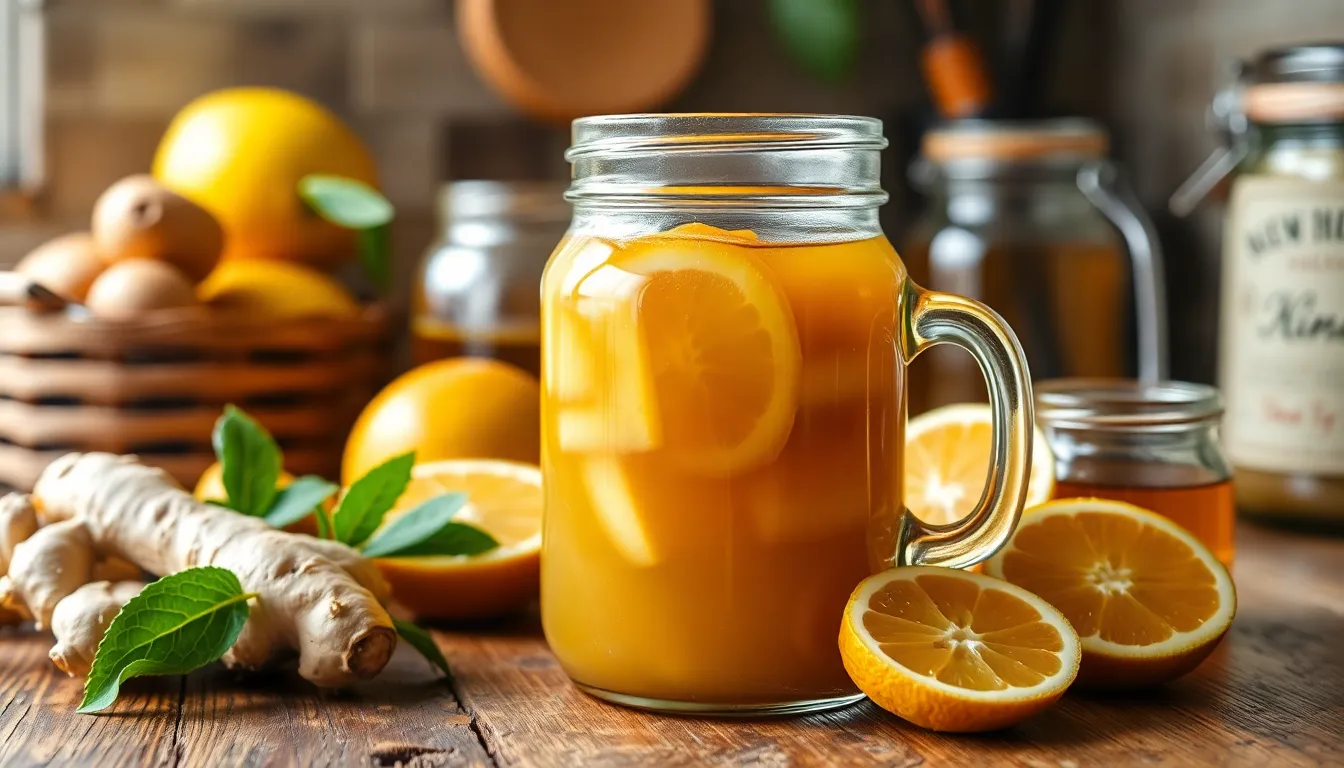
Preparing tea concentrates in advance transforms our cold-fighting routine into a convenient and efficient healing practice. These concentrated blends allow us to create potent cold remedies that we can store and use throughout the week.
Preparation Tips
Fresh ingredients deliver the best flavor and therapeutic potency for our concentrates. We should slice fresh ginger into thin pieces to maximize its surface area and release more beneficial compounds during simmering. When working with citrus fruits, we need to zest the peel carefully to avoid the bitter white pith underneath.
Honey requires special attention during preparation since boiling destroys some of its beneficial properties. We must add honey after steeping and allow the tea to cool slightly before incorporating this natural sweetener. The dissolution process happens more effectively when we stir the mixture thoroughly until no honey remains visible.
Straining concentrates removes all solid particles and creates a smooth liquid that stores better and heats more evenly. We should use a fine mesh strainer or cheesecloth to capture even the smallest herb fragments and citrus pulp.
Storage Instructions
Refrigerator storage keeps our concentrates fresh for up to 7 days when we use airtight glass jars or bottles. Glass containers prevent flavor absorption and maintain the integrity of our healing compounds better than plastic alternatives.
| Storage Method | Duration | Container Type |
|---|---|---|
| Refrigerator | 7 days | Airtight glass jars |
| Freezer (ice cubes) | 3 months | Ice cube trays + freezer bags |
Freezer storage extends the life of our concentrates to 3 months using the ice cube method. We pour the concentrate into ice cube trays and freeze completely before transferring the cubes to labeled freezer bags. This portion control system allows us to thaw exactly the amount we need for each serving.
Reheating Guidelines
Microwave heating offers the quickest method for individual servings of concentrate. We heat the concentrate in a microwave-safe mug for 1 to 2 minutes and add hot water as needed to reach our desired strength and temperature.
Stovetop reheating works well for larger quantities when we simmer the desired amount of concentrate in a small pot with extra water. We must avoid boiling concentrates that contain honey since excessive heat diminishes the honey’s therapeutic benefits. Gentle simmering maintains the healing properties while bringing the temperature to a comfortable drinking level.
We can customize our reheated concentrates by adding mint leaves for extra congestion relief or cinnamon for enhanced anti-inflammatory effects. Diluting thawed or reheated concentrate with hot water allows us to adjust the strength according to our taste preferences and symptom severity.
Dosage and Timing Recommendations
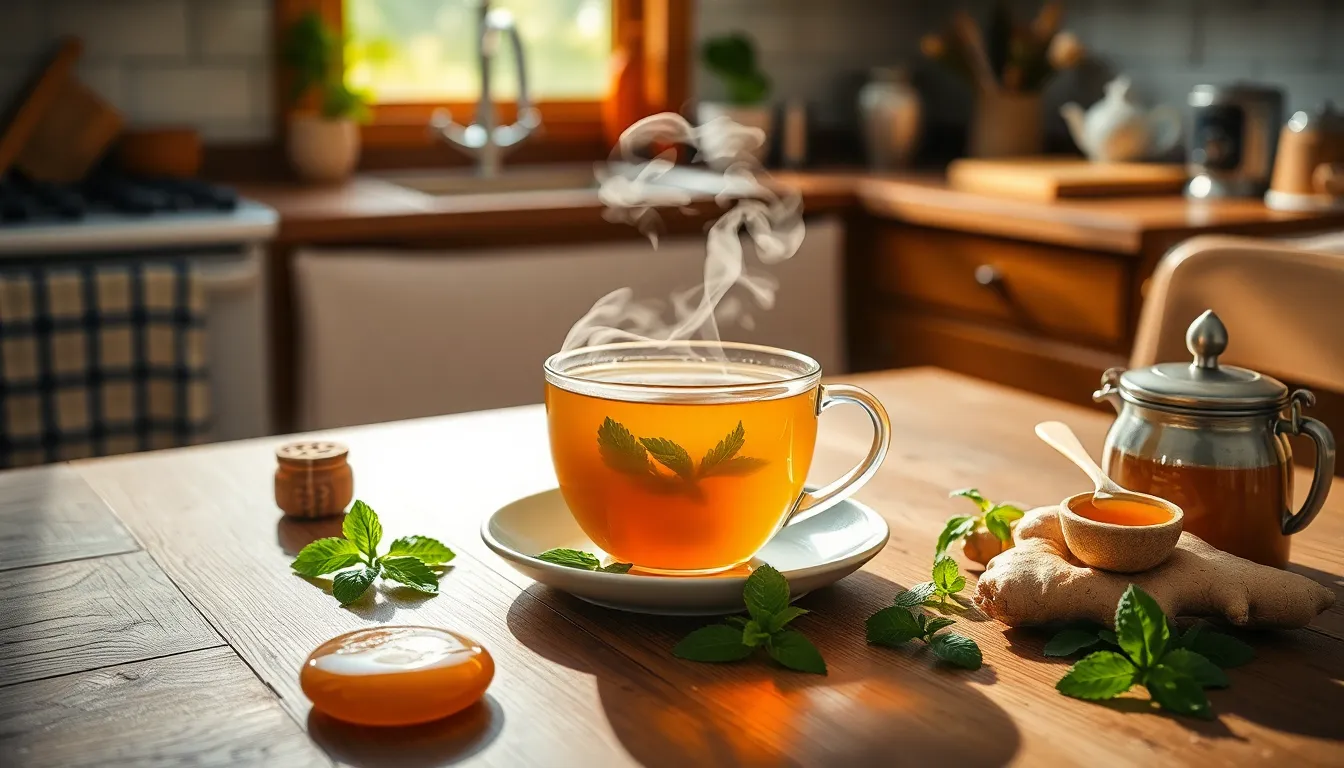
Understanding the proper dosage and timing for cold remedy teas ensures we maximize their therapeutic benefits while avoiding potential side effects. Strategic consumption throughout the day helps maintain consistent immune support and symptom relief.
How Often to Drink
We recommend consuming 2 to 4 cups of cold remedy tea daily depending on the exact blend and our individual needs. Mint tea can be enjoyed up to 4 cups per day due to its gentle nature and excellent safety profile. Guaco tea should be limited to 2 to 3 cups daily as its potent medicinal compounds require more moderate consumption.
| Tea Type | Daily Cups | Frequency |
|---|---|---|
| Mint Tea | Up to 4 cups | Every 2-3 hours |
| Guaco Tea | 2-3 cups | Every 4-6 hours |
| Honey Lemon Ginger Tea | 3-4 cups | Every 3-4 hours |
| Echinacea Elderberry Tea | 2-3 cups | Every 4-6 hours |
| Spiced Chai Cold Remedy | 2-3 cups | Every 4-5 hours |
Green tea blends should be consumed in moderation with no more than 3 cups daily to prevent excessive caffeine intake. Herbal teas like chamomile lavender can be enjoyed more frequently since they contain no caffeine and promote relaxation.
Best Times of Day
Morning consumption provides our immune system with early support and helps establish protective benefits throughout the day. We should drink our first cup of cold remedy tea within 30 minutes of waking to jumpstart our body’s natural defenses.
Mid-morning and afternoon servings maintain consistent therapeutic levels in our system while addressing symptoms as they arise. Consuming tea between meals prevents interference with nutrient absorption while ensuring steady immune support.
Evening consumption serves dual purposes by continuing symptom relief and promoting restful sleep essential for recovery. Chamomile-based blends work particularly well 30 to 60 minutes before bedtime to enhance sleep quality and overnight healing.
Pre-meal timing works best for teas containing ginger or turmeric as these ingredients support digestion while delivering their anti-inflammatory benefits. Post-meal consumption may be preferable for those with sensitive stomachs or when using particularly potent herbal blends.
Tips for Maximum Effectiveness
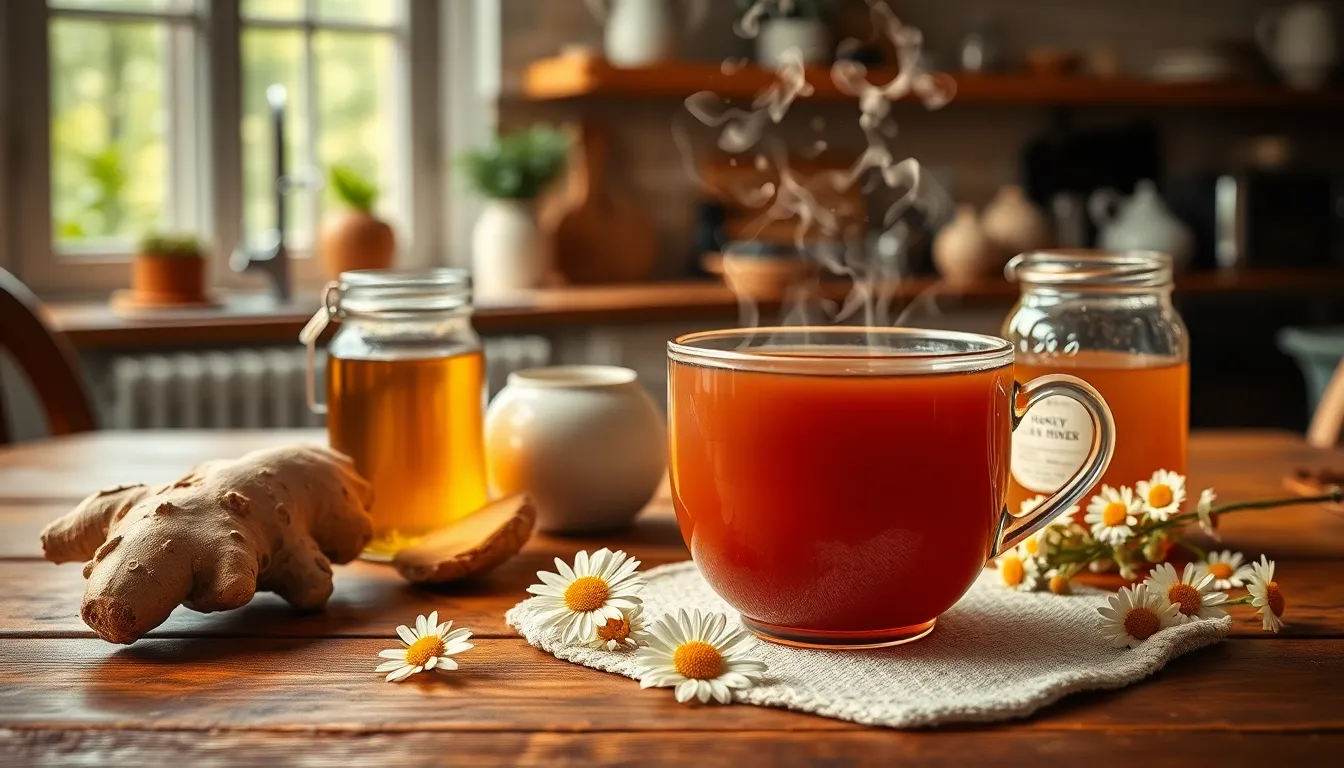
Getting the most from our cold remedy teas requires attention to brewing fundamentals and ingredient selection. We can dramatically enhance the therapeutic benefits by following these essential preparation guidelines.
Temperature Guidelines
Warm liquids provide the most effective relief for congestion and throat discomfort. We recommend using hot water for brewing our tea blends but allowing the temperature to cool slightly before drinking to prevent irritation.
The optimal serving temperature ranges between 140°F to 160°F for maximum comfort and therapeutic benefit. Water that’s too hot can actually damage the delicate compounds in herbs like honey and certain vitamins while potentially burning sensitive throat tissues.
We find that testing the temperature with a small sip ensures the tea is warm enough to provide soothing relief without causing additional discomfort. Steam from properly heated tea also helps clear nasal passages as we drink.
Steeping Times
Different ingredients require exact steeping durations to extract their maximum healing potential. We recommend steeping ginger tea for 5 to 10 minutes to fully release its anti-inflammatory compounds and warming properties.
Delicate herbs like chamomile and elderberry need only 3 to 5 minutes to avoid bitter overtones while maintaining their soothing qualities. Stronger ingredients such as echinacea and turmeric benefit from longer steeping times of 7 to 12 minutes.
We vary our steeping times based on desired strength and personal taste preferences. Longer steeping generally produces more potent therapeutic effects but may create stronger flavors that some find overwhelming.
Ingredient Quality
High-quality tea leaves and fresh ingredients produce superior flavor profiles and enhanced health benefits. We prioritize organic herbs and spices whenever possible to avoid pesticide residues and ensure maximum potency.
Fresh ginger root delivers more powerful anti-inflammatory effects than dried powder forms. Raw honey contains active enzymes that processed varieties lack making it our preferred natural sweetener for cold remedy teas.
We source elderberries from reputable suppliers and check expiration dates on dried herbs to guarantee optimal therapeutic value. Quality ingredients may cost more initially but provide significantly better results for our immune system support goals.
Conclusion
We’ve explored the powerful industry of healing teas that can transform your cold recovery journey. These natural remedies offer more than just comfort – they’re scientifically-backed answers that work with your body’s natural defenses.
The beauty of these tea recipes lies in their simplicity and accessibility. With basic ingredients from your kitchen and proper brewing techniques you can create potent healing elixirs that rival any store-bought remedy.
Remember that consistency is key when using these natural treatments. Regular consumption throughout the day paired with quality ingredients and proper preparation will give you the best results for symptom relief and immune support.
Start brewing these therapeutic teas today and experience firsthand how nature’s pharmacy can support your wellness journey. Your body will thank you for choosing these gentle yet effective alternatives to conventional cold treatments.
Frequently Asked Questions
What are the best teas for fighting cold symptoms?
The most effective cold-fighting teas include Honey Lemon Ginger Tea for sore throats, Echinacea Elderberry Tea for immune support, Turmeric Golden Milk Tea for inflammation, and Peppermint Eucalyptus Steam Tea for congestion. These blends combine powerful ingredients like ginger, honey, healing herbs, and citrus fruits that are rich in antioxidants and immune-boosting properties.
How often should I drink cold remedy teas?
For optimal therapeutic benefits, consume 2 to 4 cups of cold remedy tea daily, depending on the specific blend. Start with morning consumption to jumpstart your immune system, continue with mid-morning and afternoon servings for consistent support, and finish with evening tea to promote restful sleep and recovery.
What ingredients make tea most effective against colds?
The most powerful cold-fighting ingredients include fresh ginger for anti-inflammatory properties, raw honey for antimicrobial benefits, lemon for vitamin C, turmeric for immunity, peppermint for congestion relief, and echinacea for immune support. Medicinal add-ins like elderberry syrup, apple cider vinegar, and cayenne pepper enhance the therapeutic effects.
What temperature should cold remedy tea be served at?
Serve cold remedy tea at 140°F to 160°F for optimal effectiveness. While hot water is recommended for brewing to extract maximum healing properties from ingredients, allow the tea to cool slightly before drinking to avoid throat irritation and ensure comfortable consumption while maintaining therapeutic benefits.
How long should I steep cold remedy teas?
Steeping times vary by ingredient to extract maximum healing potential. Herbal teas typically need 5-10 minutes, while delicate ingredients like green tea require 3-5 minutes. Fresh ginger and turmeric benefit from longer steeping (10-15 minutes), while citrus should be added after steeping to preserve vitamin C content.
Can I make cold remedy tea concentrates ahead of time?
Yes, make-ahead tea concentrates are convenient and effective. Prepare concentrated versions by using double the ingredients and half the water, then store in the refrigerator for up to a week. Simply dilute with hot water when ready to drink, maintaining therapeutic potency while saving preparation time.
Should I use organic ingredients for cold remedy teas?
Organic herbs and spices are highly recommended for cold remedy teas as they ensure maximum potency and effectiveness without harmful pesticides. While quality organic ingredients may cost more, they provide significantly better therapeutic results, superior flavor, and enhanced immune support compared to conventional alternatives.
When is the best time to drink cold remedy tea?
The optimal timing includes morning consumption to boost your immune system, mid-morning and afternoon servings for consistent symptom relief, and evening tea to promote restful sleep. Consider pre-meal timing for digestive teas and post-meal consumption for certain blends to enhance absorption and effectiveness.

